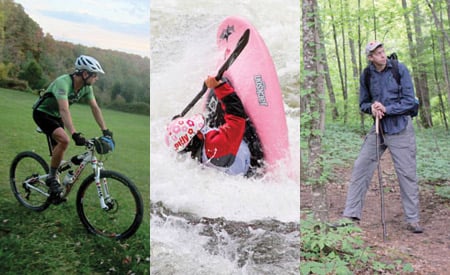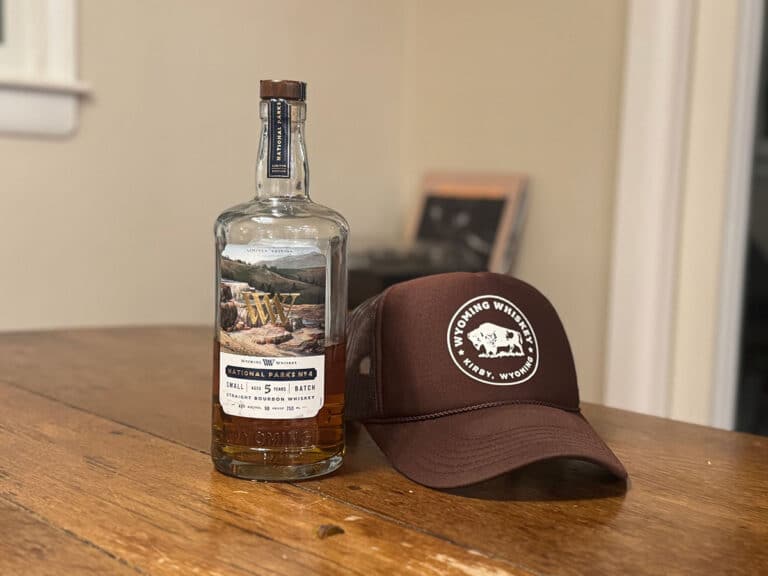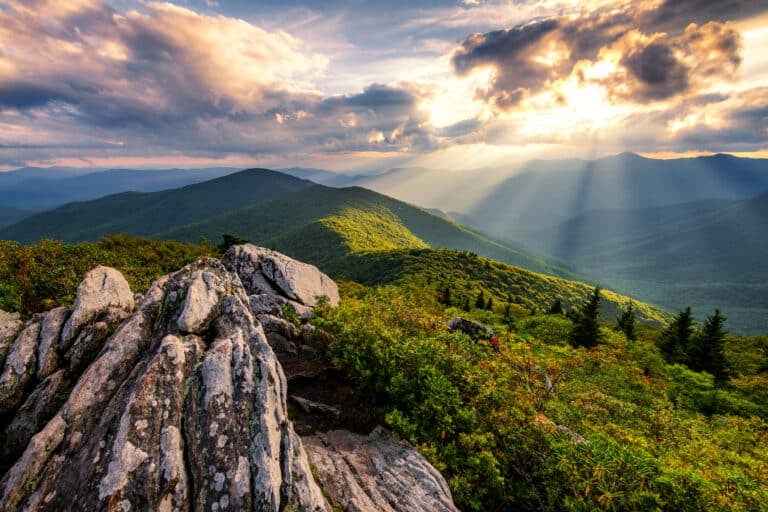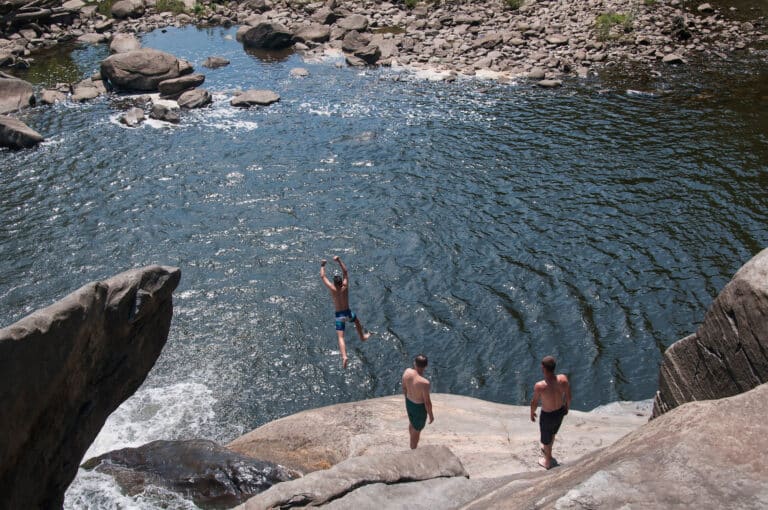When you think of big adventure, most folks picture grizzled athletes battling against the elements of an exotic landscape. They often overlook the athletes in our region who are embarking on equally epic feats. Meet Bill, Emily and Chris, three Blue Ridge natives who have turned a passion for adventure into a lifestyle. From long-distance backpacking to kayaking and mountain biking, these three athletes have set the bar high for adventure in the Blue Ridge and beyond. They are the Best Athletes in the Blue Ridge:
Chris Scott: Mountain Biker
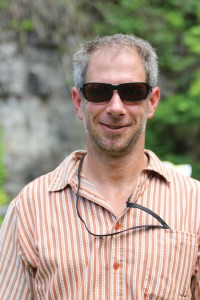 Fast Facts
Fast Facts
Name: Chris Scott
Age: 44
Hometown: McLean, Va.
Outdoor activity: Mountain biking
Post-biking tradition: I don’t know about post-biking, but my tradition is just to get out and ride once or twice a day.
Biggest fear: Not being healthy enough to recreate in the woods
Dream excursion: Italy. I want to go from the mountains and drop down into the coast.
Lessons learned: Check your tire pressure before you ride. Wear clean bicycle shorts. Don’t force it. Love it.
Google Virginia mountain biking. The second search engine result mentions Chris Scott. A Commonwealth native, Scott is one of the Southeast’s leading advocates for mountain biking and has been tearing up the trails of Virginia for the past 25 years. Under the same Google search, you’ll find Shenandoah Mountain Touring’s page a few scrolls down. In 1999 Scott created SMT, based out of Harrisonburg, Va., with two of his fellow riders. Together, the team created a business that not only prides itself on recreation but also strives to protect the wild playgrounds in and around the George Washington National Forest.
“Biking has taught me to be a steward of the land,” Scott says. “You never realize how important it is to protect these wild places until you’re in them, experiencing them and recreating in them.”
Scott’s environmental consciousness stems from a long history of working and living with the land. When he first started mountain biking at 18 years old, he was working at a landscaping company.
“When it rained, we biked,” he says. “About the only time I could get out to ride was when the weather was awful, but I loved it.”
Scott knew of a few people who mountain biked, but since the ever-so-convenient resources available on the internet had yet to be developed, Scott turned to races and other biking events to broaden his biking gamut.
“The only way you were going to get to know a new trail was if you signed up to race on it,” he says. “At the time, there were hardly any maps let alone mountain-bike-specific parks or campgrounds. It was a social-driven show.”
Scott’s social butterfly beginning quickly opened new doors for him, but there was always something more than the fun, close-knit camaraderie of the mountain biking world that drew him to the woods.
“I love riding by myself,” he says. “I like the solitude of the backcountry and the ability to ride faster or slower and take breaks when I want. When you’re out there alone, you can do everything on a whim. It all boils down to what I feel in the moment, and you can’t compare that to anything.”
From being a bike messenger in Washington, D.C. to competing in 24-hour endurance races, Scott has probably racked up more hours in the saddle than in his bed. When he opened SMT over 14 years ago, and more recently the accompanying Stokesville Lodge and Campground, Scott knew he was making a lifelong commitment to his passion.
“I like that biking allows you to take yourself to new limits,” he says, “but it also teaches you to respect the terrain. All it takes is one bad jam in your tire and you’re over the handlebars.”
Despite having spent the majority of his life in Virginia, Scott has not restricted his mountain biking travels to the East Coast. From New Zealand to Mexico and Canada, Scott’s taste for adventure keeps him busy with big plans to do big things.
“No matter where I am, though, every time I’m in one of those amazing places I’m missing my home trails. There’s nothing like home,” he says.
During the rare moments when Scott is not on his bike, he can usually be found donning a chef hat and catering to that social butterfly side of his.
“I love cooking for people,” he says. “Right now, my signature dish is fresh corn tortillas stuffed with chorizo and just about anything and everything else. But my cookies and my cinnamon swirl French toast are definitely classics.”
The Epic
Scott’s epic moment did not come the three different times he broke his leg after a car ran into him while road biking. It didn’t come when he was riding the narrow cliffs in New Zealand and dropping off steep ledges in Arizona. It didn’t even come when he flew over the handlebars and separated his shoulder during his two weeks on the Virginia Mountain Bike Trail. For Scott, his epic moment came on the last day of that Virginia Mountain Bike Trail experience when he and his crew were only hours from the end point in Damascus, Va.
The Virginia Mountain Bike Trail was merely a dream, a passing thought, to a few of the region’s avid mountain bikers. For Scott and his friends though, it was becoming much more than that; it was becoming an all-consuming, must-have goal. After over a decade of exploring, maintaining, and linking Virginia’s trails, Scott and a group of fellow cyclists pioneered the long distance backcountry trail in the fall of 2011. The route would cover 480 miles, climb 65,000 feet and take approximately 12 days.
“The whole two weeks had been amazing because we were able to experience fall coming on throughout Virginia,” he says. “When I separated my shoulder, we were near New Castle. My pedal clipped a rock and I basically landed on my head.”
No matter. Scott continued on, concerned more about completing the trail than the lasting impact the wear and tear might have on his now-fragile shoulder. When the riding team arrived at the Iron Mountain Trail in Damascus, Va., the previously glorious autumn weather had acquired a wintery bite. As the temperature quickly dropped to 40°F, a blinding rain settled in.
“Everyone in the group was struggling,” Scott says. “We couldn’t feel our hands and the downpour wouldn’t let up. But that closing of the accomplishment kept me warm and fuzzy inside.”
When the bikers cruised out of Mock Hollow and onto Main Street, they were frozen, drenched, and weary but elated at the thought of having successfully executed their goal and their dream.
Recommended Ride
Nestled deep in the George Washington National Forest, the Shenandoah Mountain Trail is a classic Virginia ride. Located near Harrisonburg, Va., the trail itself offers everything from steep climbs to technical rock gardens, twisty-smooth singletrack, and gorgeous ridge views.
“The best time to go is in the early spring on a day with full visibility and before the blooms come out,” says Scott.
The 17-mile singletrack ridge ride can be combined with the Southern Traverse for a longer, intermediate-advanced ride. The Southern Traverse is not only epic and challenging, but also historic. Civil War soldiers were the ones to stomp out the trail in the late 1800s and the trailhead itself is located at an old Confederate army camp that was used to prevent Union soldiers from reaching the Shenandoah Mountain. If you’re a history buff and cycling maniac, this 32-mile ride is for you.
For more information on the Shenandoah Mountain Trail, check out the MTB Project website at mtbproject.com. Need a shuttle, bike, or guided ride? Visit mtntouring.com for all the answers you need for mountain biking in Virginia.
Emily Jackson: Whitewater Paddler
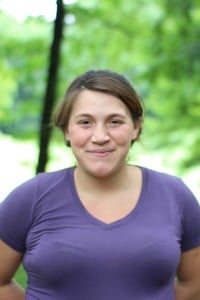 Fast Facts
Fast Facts
Name: Emily Jackson
Age: 23
Hometown: Born in Washington, D.C., raised on the road, based in Rock Island, Tenn.
Outdoor activity: Whitewater paddling
Post-paddling tradition: The paddling itself is the tradition
Biggest fear: Losing total control
Dream excursion: Antarctica, so I can say I’ve been to all seven continents
Lessons learned: Don’t listen to where other people think your comfort level should be. Never let other people load your gear or you’ll end up being shuttle bunny. Don’t be afraid to try the most advanced of things; you’ll never know what you might learn.
At only 5’3”, Tennessee native Emily Jackson’s unassuming build and innocent smile speak nothing of her ability to kayak equal to, or oftentimes better than, the leading male paddlers of her day. At 23 years old, Emily has been the women’s 2012 ICF World Cup Champion, the 2009 women’s World Freestyle Champion and seven-time Teva Mountain Game winner along with many other impressive titles. Her accomplishments are not surprising though, given she and her younger brother Dane were raised in a motorhome by a father who just happened to be a world-renowned kayaker.
“One of my dad’s most frequently used analogies is that if you’re in an Indian tribe and you see everyone buffalo hunting, chances are you’ll grow up to be a buffalo hunter too,” Emily says.
Although Emily and her brother initially chose not to paddle as frequently as their father, she says that once her brother started kayaking everyday, it quickly became a family event.
“Dane was a bit more inclined to dive into the water than I was,” she says, “but he’s three years younger, so if he can do it, I really have no excuse.”
Although her river rat genes most certainly came from her father, Emily says her mother can hop in a boat and paddle downriver just as easily as she can hit the pavement running or cycling.
“Honestly, she won’t go in the water unless it’s 90 degrees out, but we ran a marathon and biked a Century Ride together in the same month,” she says.
When the Jackson family began a kayak-making business in 2003, their name grew in recognition; from regional to international levels, Jackson was the up-and-coming brand (both of boats and of boaters) that was taking hold of the world’s whitewater paddling community. The financially strained days of the RV lifestyle diminished with time, yet it was more the family’s success, rather than the struggles, that shaped Emily’s values.
“Throughout my life I have worked really hard to be financially independent,” Emily says. “I still have friends in D.C. where I was born, and their parents always thought I’d be behind and I’d never make it because I was the hippie that lived in a van by the river. But I’ve learned there are different ways to go through life and get to where you want to be.”
Emily has most certainly taken leaps and bounds in getting to where she wants to be. Already a homeowner, wife, and mother to a 1-month-old boy, Emily says she couldn’t be happier with her life and doesn’t expect her kayaking career to slow down in the slightest.
“When I was eight months pregnant, I was still play boating every day,” she says. “The doctors’ orders were to listen to my body, but they probably didn’t know the full extent of what I was doing. Their number one rule was, if you’re body is accustomed to it, keep doing it.”
Despite maintaining a consistent training schedule and even competing (and winning) at some of the country’s top freestyle events, Emily always received a clear health check from the doctor.
“Maybe if I hadn’t paddled every day, I would have had high blood pressure or other complications,” she says, reaffirming her belief that paddling is innately good for the human spirit.
“When you’re paddling, the situation is constantly changing,” Emily says. “You have to learn to deal with it, and that lesson can be factored into a lot of situations in life.”
Emily has very aptly been able to deal with the fluctuations in her own life, but she says her newborn baby and her seemingly traditional family will continue to be anything but.
“Things will change dramatically. That’s life. But at the same time, the things that I don’t want to change aren’t going to. If I want to travel for 10 months and paddle around the world, I’m going to make it work,” she says.
Aside from a competitive nature, this determination is one of Emily’s defining characteristics and is likely the source of her success, both on and off the water.
“My biggest fear is losing total control of everything,” she says. “That’s what I love about kayaking. I love that it’s an individual sport. When you’re in control of yourself, every one of your decisions determines your future.”
The inherent dangers of whitewater paddling seem to be the furthest thing from the new mother’s mind. Emily’s experience living on the road makes her acutely aware of the uncontrollable variables you are exposed to while performing everyday tasks like driving.
“Kayaking can be reckless if you don’t know what you’re doing or you have inadequate safety equipment. Sometimes I feel like I’m more nervous on the drive to the river than I should be while I’m actually on the river.”
The uncertainty of the road doesn’t hold Emily back, given how much she values traveling, especially for her child’s future.
“I never want my son to lose his sense of learning, and I think traveling is a great way to keep that,” she says. “I’m a little more protective than my parents were, but my son will definitely be a kayaker.”
The Epic
Imagine competing in the freestyle event at the nation’s premier adventure competition, the Teva Mountain Games, in Vail, Colo. Thousands of spectators squeeze onto the sidewalks lining Gore Creek at Vail Whitewater Park. Photographers, videographers and journalists from all over the country have their eyes and lenses glued to the boaters sitting in the eddy, waiting for their 1-minute surf session. The pressure is on as one by one, they peel out into the current and slide into the churning wave to attempt their Phonics Monkeys and Donkey Flips.
Seems stressful, but Emily’s no stranger to this scene. After six consecutive TMG wins, this was obviously not her first rodeo show.
“The water levels shot up as we were paddling,” she says. “You could literally see the water flooding higher and higher causing the spectators to run up to higher shore.”
Emily surfed first one round, then two, then three with no success. The big and brown waters of Gore Creek surged and crashed all around, carrying logs and full-size trees downriver.
“I wasn’t able to stick a single move on my first rides, leaving me in 5th place against the women,” she says, “and here I was trying to win it seven years in a row.”
The crowd was on edge as Emily peeled out into the raging current for her final surf. The roar of the water drowned out the spectators’ cheers and Emily zoned in on her boat, the current, the hole, nothing else. She stuck her blade to her bow and swept forward to initiate a McNasty. When she realized she had stuck the move, she buried her bow for a loop and another final move, bumping her from 5th place to first in a matter of seconds.
“It felt like the world was throwing everything it could at me and yet somehow, I still prevailed.”
Recommended Paddle
Located in the jungle-like mountains of West Virginia, the Gauley River is perhaps one of the East Coast’s most beautiful rivers. The Gauley winds for 25 miles through an expansive gorge, the height of which has been chiseled down to 500 feet in some places by the river’s powerful flow. The exposed bedrock, massive boulders and variety of whitewater make it a hotspot for climbers and paddlers alike. Emily has only three things to say about the Gauley.
“Big water, fun play spots, and creeking lines!”
What more could you ask for?
Unless the spring rains bring natural flow, the Gauley River typically runs in September and October, with scheduled releases beginning the first weekend after Labor Day and continuing for the next six weekends (plus the Sunday of Fayetteville’s Bridge Day celebration). For flow levels, call the US Army Corps of Engineers’ public telephone line at 304-872-5809.
Bill Walker: Long-distance hiker
 Fast Facts
Fast Facts
Name: Bill Walker
Age: 52
Hometown: Macon, Ga.
Outdoor activity: Hiking
Post-hiking tradition: Gain weight back dramatically
Biggest fear: Meaninglessness
Dream excursion: Experience and live in Africa in an authentic way
Lessons learned: Carry a stove. Don’t play poker with anyone named Slim. Put olive oil on everything.
Bill Walker, long-distance hiker, author, and self-proclaimed Skywalker, could not have chosen a more suitable last name. Having thru-hiked the Appalachian Trail, the Pacific Crest Trail, Europe’s El Camino de Santiago, and Nepal’s Annapurna Circuit, Walker truly has done his fair share of walking. He is 6’11”, wears size 15 shoes, and that’s only the beginning of a long string of surprising facts about this unique athlete.
Having attended the University of Georgia to obtain a master’s degree in accounting, Walker spent 14 years of his life working as a commodity futures trader. From the Chicago Board of Trade to the heart of London, Walker eventually realized that he desperately needed a change of pace.
“That naked pursuit of money, at the end of the day, brings out the worst in people,” he says. So he moved to Latin America to teach English as a Second Language.
Despite being in his late thirties at the time, Walker quickly adapted to his new lifestyle, living in Mexico, Argentina, Brazil, Paraguay and Peru all within a three-year span. When his father became ill, he returned to the States. Soon after his father died, Walker vowed to make the 14-state-trek through the mountains.
Although his long history of “street walking,” as he calls it, might have prepared his knees for the upcoming 2,185.9-mile trek, Walker was a 44-year-old who had never spent a single night in the woods. Nonetheless, he had his mother drive him up U.S. Forest Service Road 42 to the Springer Mountain Trailhead, and in the spring of 2005, Walker began his northbound journey on the Appalachian Trail.
“Thus began this 171-day, cease-all battle between my incompetence or blunders on the one hand, but determination on the other,” he says.
His determination ultimately prevailed, despite enduring countless cold nights and losing 33 pounds from his already-lean frame. Instead of dousing his curiosity for new experiences, however, Walker’s successful thru-hike merely fueled the fire.
“That’s one of the great things about the Appalachian Trail,” he says. “It allows an average person of average abilities to go out and do something that most people would consider extraordinary. It’s America’s great trail of the masses. It has unmatchable community and camaraderie.”
For Walker, long-distance hiking provides a means of combatting an obesity- and anxiety-ridden society through, what he calls, a “low level ecstasy.”
“American life is so full of adrenaline rushes, highs and lows. But hiking is a different kind of thing,” he says. “Your morale slowly builds throughout the day. I think in a lot of jobs, their morale is not that great at the end of the day, and that just doesn’t happen with hikers.”
Having hiked over 5,500 miles around the world, Walker says he is grateful for this mid-life discovery and has no regrets about the timing of his hiking experiences.
“There’s something about humans on the move that I think brings out the best in them and makes them happier,” he says, citing the “unbounded freedom and discipline” of the hiker lifestyle that keeps him inspired to see more. “You feel almost like you’re getting two or three years worth of living for that five or six months you’re out there.”
For Walker, it’s not the highpoints of the hike that make the experience worthwhile; it’s the trial and tribulation he overcomes each and every day. He says these challenges are, by nature, synonymous with not only the trail, but travel in general; the root of the word “travel” comes from the Anglo-French word “travail,” which denotes some sense of torture, agonizing effort, or beleaguerment.
“If you travel by foot,” he says, “you’re going to have some beleaguered times.”
The Epic
Walker’s beleaguered times began early on during his thru-hike of the Appalachian Trail.
“The old A.T. hiker motto is, ‘No rain, no Maine,’” he says, “but on the fourth day of the trail, the weather had gone from bad to worse to outright diabolical the higher I climbed.”
As an amateur, yet borderline incompetent, hiker, Walker (now Skywalker) began to fully grasp just how difficult the thru-hike would be with every heavy step he took. Primal fears sank in as he trudged his way along the sloppy trail, hoping, praying he would make all twenty miles from Neel’s Gap to Unicoi Gap.
“I had gotten completely drenched, mildly hypothermic, and worst of all I began to feel lightheaded,” he says.
The unfortunate combination of inexperience and spring weather eventually got the best of Skywalker. He ditched his pack, which contained the thousands of dollars of equipment he had spent all winter purchasing, hiding its sopping mass in the bushes. Then he continued down the mountain without any supplies, finally arriving at a road crossing in the evening. It was dark and Skywalker was miserably numb from being wet and cold all day, yet he stood to the side of the road with his thumb out and gratefully accepted a ride down to Helen, Ga. Luckily for Skywalker, he survived the night and the following morning. He hitched back up to the trail and recovered his untouched belongings.
“The anxiety from this incident lingered,” he says. “I would feel a deep-down-in-the-bone weariness for weeks, as well as harbor a gut-level fear of hypothermia.”
Recommended Hike
“When you reach New Hampshire, you have completed 80% of the trail, but 50% of the difficulty and effort lie ahead.”
Those were the foreboding words Walker read in his Appalachian Trail guidebook as he stood at the base of Mount Moosilauke, the gateway to the White Mountain National Park. Despite its renown for being one of the more difficult and rocky sections on the trail, Walker says its exotic landscape make it a must-do hike on anyone’s list of great Appalachian Trail vistas.
“The craggy southern Appalachians had a certain masculine beauty about them, while the Blue Ridge’s romantic haze and lush majesty connoted a more feminine romance,” he says. “But the stark ambience of the Presidential Range had a rugged, Yankee bleakness about it that was all its own. Indeed, I immediately felt myself stirred to my greatest depths by this powerful scenery.”
To plan your hike to the Whites, visit hikethewhites.com. Interested in following Skywalker’s travels? Visit skywalker-pct.com for more details.
